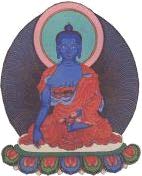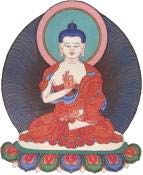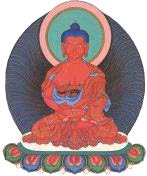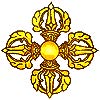Roof
Five Directions Buddhas Topics
Roof Topics
Five Directions Buddhas
Location Description
As you climb up onto the roof from one of the four corner staircases, you will come upon one of the 4 small pavilions, which houses one of the Five Buddhas of the Cardinal Points. When you look towards the center of the roof level, you will see a large, tall Ten Thousand Buddhas Pagoda housing the large Vairocana Buddha Prayer Wheel, in the center. You will also notice the other pavilions with their respective Buddhas of the Cardinal Points. The open orchid garden in between is filled with numerous Dendrobium Buddha Tooth orchid plants and other orchid plants as well as local trees and shrubs.
Five Directions Buddhas in Buddha Tooth Relic Temple & Museum
At the center of the Ten Thosand Buddhas Pagoda is the huge Vairocana Prayer Wheel, specially produced by cloisonné enamel so as to give it a bright, colourful, intricate and glossy look. It has 3 layers of Vairocana Mantras within bright borders. The Wheel sits on a granite cladded base. Every complete turn of the wheel will result in a ring of the wheel bell.
There is a Pagoda in the center and a Pavilion in each of the four corners of the top floor, in which the Five Jinas (Conquerors), or Five Great Buddhas of Wisdom, or Five Buddhas of the Cardinal Points are enshrined and worshipped. They are:
- Vairocana Buddha (Resplendent Buddha) of the Center Realm;
- Aksobhya Buddha (Immovable Buddha) of the Eastern Realm of Fragrance;
- Ratnaketu (Ratnasambhava) Buddha (Jewel Born Buddha or Buddha of Treasured Appearance) of the Southern Realm of Happiness;
- Amitabha Buddha (or Buddha of Limitless Life) of the Western Realm of Tranquillity and Bliss;
- Amoghasiddhi Buddha (Infallible Buddha or Buddha of Subtle Hearing), of the Northern Realm of the Lotus.
The five wisdom merits are the Dharmahdatu-prakriti-jnana or the ability to show the Truth, Adarshana-jnana or the ability to see the original nature of all living beings, Samata-jnana or the way to adopt an indifferent attitude, Pratyaveksana-jnana or the ability to see the special character of all living beings, and Krityanushthana-jnana or ability of all complete meritorious.
About Five Dhyani Buddhas
These five Buddhas are a common subject of Vajrayana mandalas. These five Buddhas are the primary object of worship and meditation in Shingon Buddhism, a school of Vajarayana Buddhism founded in Japan by Kūkai.





(Realm of)
(Fragrance)
(Happiness)
(Tranquility)
(August Lotus)
(Consort)
(Mount)
(touching the earth)
(bestowing blessings)
(turning the dharma wheel)
(meditating)
(granting protection)
(thunderbolt)

(wish-fulfilling jewel)

(wheel)

(alms bowl)

(double thunderbolt)

Names in other languages:
毘盧遮那佛 Pílúzhēnà Fó
Development of Buddha Tooth Relic Temple & Museum - Five Directions Buddhas
These statues were handcrafted by Mr Huang Yusuo from Putian, China and hand painted by Shanghai You Shan Guan Decorate Design Co Ltd.
Bibliography:
Lokesh Chandra, Dictionary of Buddhist Iconography, International Academy of Indian Culture and Aditya Prakashan, 1999, Vol 4, pages 1128 - 1129
Louis Frederic, Buddhism, Flammarion Iconographic Guides, 1995, ISBN 2-08013-558-9, page 124 - 146
Meher McArthur, Reading Buddhist Art, An Illustrated Guide to Buddhist Signs & Symbols, Thames & Hudson,2002, pages 34 - 41
Charles F Chicarelli, Buddhist Art, An Illustrated Introduction, Silkworm Books, 2004, ISBN 974-9575-54-7, pages 262 - 263
Lokesh Chandra, Fredrick W. Bunce, The Tibetan Iconography of Buddhas, Bodhisattvas and other Dieties, D. K. Printworld, 2002, ISBN 81-246-0178-X, pages 162 - 171
Websites:
Five Dhyani Buddhas - Wikipedia, the free encyclopedia
Vairocana - Wikipedia, the free encyclopedia
Symbolism of the five Dhyani Buddhas
Godai Nyorai - The Five Tathagata, Especially Important to Shingon Sect of Esoteric Buddhism in Japan
The Five Buddha Families - Shambhala
Buddha-Family Traits (Buddha Families) and Aspects of Experience